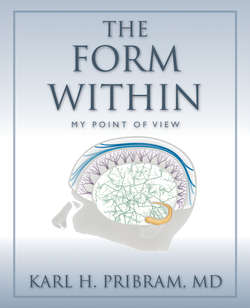Читать книгу The Form Within - Karl H Pribram - Страница 32
На сайте Литреса книга снята с продажи.
Try It Yourself
ОглавлениеYou can simply and directly demonstrate how the holographic process works by using an ordinary slide projector. Project the image of a slide on a large white screen and then remove the lens of the slide projector. Now you see nothing on the screen but a big bright white blur of scattered light. But if you take a pair of ordinary reading glasses and hold them in the array of light between the projector and the screen, you will see two images appear on the screen wherever you place the two lenses of your glasses. No matter where you hold the reading glasses in the scatter field of the projected light, the two lenses will create two distinct images of your original slide on the screen. If four lenses are used, four images will appear on the screen. A hundred lenses would produce a hundred images. The “information,” the pattern contained in the original image, in the absence of the lens, becomes spread, scattered. The lens restores the image. As the demonstration using the projector indicates, lenses such as those in our eyes or in the slide projector perform a transformation on the “information” that is scattered in the light: patterns that seem to be irretrievably annihilated are in fact still present in every portion of the scattered light, as the evidence from the use of the eyeglass lenses demonstrates.
Gabor based his holographic procedure on transforming the space and time coordinates of our experience, within which we navigate every day of our lives, into a spectrum of interference patterns. My hope from the earliest days of my research had now been realized: that we might one day achieve an understanding of form in terms of spectra akin to that which we had for our perception of spectra of color.
But the form that the answer to my hopes took, and the broader implication for our understanding of how we navigate our universe (as indicated in Appendix A), was and still is to me, totally surprising.
The spectral processing of color and the spectral processing of patterns must become meshed in the brain. Russ and Karen DeValois, on the basis of their research, have been able to construct a single neurological network that can process both color and pattern, depending on how that network is addressed. The addressing can be initiated either by the visual input or from a higher-order brain process. Their network accounts for the observation that we rarely see color apart from form.
Chapters 4 to 8 tell the story of how the scientific community has dealt with the insights derived from these new ways of thinking, ways derived from the metaphors and models that have been outlined in the current chapter.
10. A complete diagram of the proposed stage 3. Russ and Karen DeValois’s Spatial Vision
